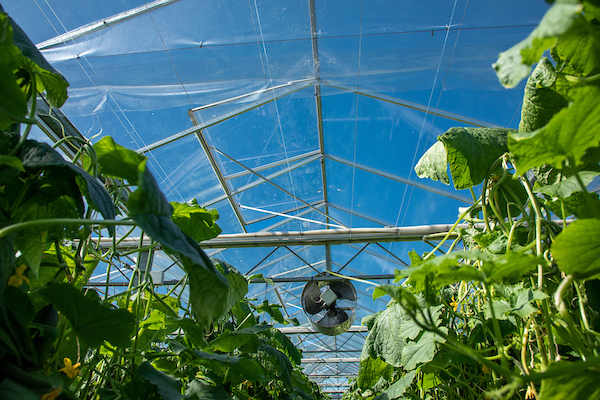Please click here to access the main AHDB website and other sectors.
- Home
- Knowledge library
- Managing climate for Mycosphaerella control
Managing climate for Mycosphaerella control
This information was last updated in 2015.
Find guidance on how to manage your glasshouse climate, including temperature and humidity, to help keep Mycosphaerella under control.
Humidity
Moisture content of the air is the main thing to consider.
As a general guideline, avoid relative humidity (RH) above 85%, humidity deficit (HD) above 2.8, and dew formation.
Note that, especially in the autumn crop, it is important to maintain high enough RH in case of Botrytis stem infections.
Low RH and rapid plant death
Research has shown that Botrytis stem infections, which occur mostly in autumn, will more rapidly lead to plant death in low RH conditions. This is because it causes the Botrytis to grow more aggressively into the stem and kill the parenchyma tissue. In contrast, it grows more superficially on the stem in more humid conditions (Dik & De Koning, 1996).
An increase in humidity deficit (HD) of 2.0 strongly increased death of plants due to Botrytis (Dik & De Koning, 1996).
A decrease of 10% in 24-hour average RH at the same temperature strongly increased death of plants in the autumn (Dik et al., 2010).
Air temperature
Aim to start heating at least three hours before sunrise.
This will prevent a sudden increase in air temperature with a low crop temperature shortly after sunrise.
Heating may even start from midnight, with a raise of 0.5 ̊C per hour to prevent Mycosphaerella.
Slow increase
Do not allow the heating to increase the greenhouse temperature by more than 1 ̊C per hour.
Ventilation should start early to prevent high RH.
If guttation droplets are present on the crop in the early morning, it suggests the irrigation and climate management are incorrect and measures should be taken to rectify this.
Thernal screens
Thermal screens should be used wisely.
Open the screens slowly to prevent sudden changes in temperature and RH.
Using an extra sensor above the screen may help to stop the screens from opening prematurely when temperature differences above and below the screen are too large.
Ventilation
Using ventilators lowers RH and should help reduce stem infection.
It also helps to reduce horizontal differences in temperature and RH.
Internal fruit rot may increase because transpiration of the crop (and so, humidity) in the flowers, is increased.

Using vents, apex seals and fans to manage the glasshouse climate and help control disease levels
Outside air
Dry outside air can be used to reduce the RH.
This is a relatively new approach, but growers in the Netherlands have seen a reduction in Mychosphaerella problems.
Useful links
Find more information and resources on cucumber
Download a PDF version of the original factsheet on Mycosphaerella
Find out more about climate management by visiting the GrowSave website
Authors
This information was originally authored by Aleid Dik and Martin McPherson

